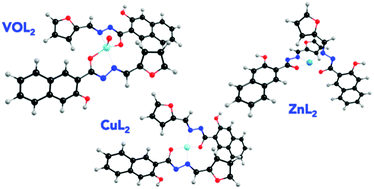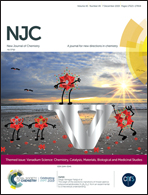Naphthoylhydrazones: coordination to metal ions and biological screening†
Abstract
We report the synthesis of 3-hydroxyl-2-naphthoylhydrazones containing pyrrole (HL1), furane (HL2) and thiophene (HL3) moieties and their V(IV)O-, Cu(II)- and Zn(II)-complexes. All compounds are characterized by the usual analytical techniques and coordination of the ligands to the metal ions is discussed based on spectroscopic data (FTIR, UV-vis, EPR and NMR) as well as CAMB3LYP DFT/TDDFT calculations, indicating the formation of neutral ML2 type complexes. The photophysical properties of ligands and complexes are disclosed. The binding to Bovine Serum Albumin (BSA) is evaluated in detail using several spectroscopic tools. Circular dichroism shows that the compounds, and particularly the ligand precursors, stabilize BSA, increasing its α-helical content. Fluorescence studies indicate the formation of 1 : 1 protein–compound adducts, which is corroborated by molecular docking studies that show the interaction between Trp 213 of BSA and the naphthalene rings. The general toxicity is evaluated using the Artemia salina lethality assay, with all compounds showing general toxicity towards the brine shrimp model. The cytotoxicity on human cancer cells (H1299, MCF7, and HCT116) is assessed for all compounds and the half-maximal inhibitory concentration (IC50) values are in the range from 0.57 to 27.35 μM. Compounds containing L1 (pyrrole derivative) are the most cytotoxic, with the vanadium and zinc complexes performing better than the copper ones, and some of them depicting IC50 values lower than 1.1 μM. However, selectivity needs improvement as the compounds show toxicity towards Artemia salina and normal fibroblasts.

- This article is part of the themed collection: Vanadium Science: Chemistry, Catalysis, Materials, Biological and Medicinal Studies


 Please wait while we load your content...
Please wait while we load your content...